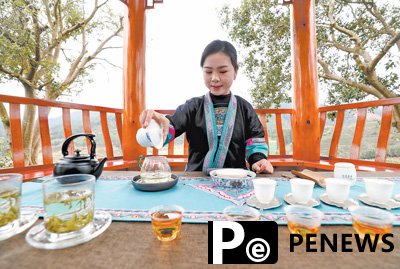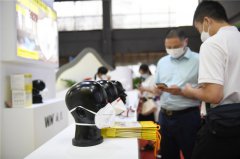Home>>
China’s tea industry brims with vitality alongside growing shift towards consumption upgrading(People's Daily Online) 17:57, February 24, 2022
In recent years, China’s tea industry has continued to flourish and has embraced a variety of new business models. Domestic tea consumption exceeded 2.3 million tonnes in 2021, and generating a sales volume of 300 billion yuan (about $47.43 billion), according to the China Tea Marketing Association (CTMA).

A lady of the Dong ethnic group performs traditional tea art in Guanghui village, Guyi town, Sanjiang Dong autonomous county, south China's Guangxi Zhuang Autonomous Region. (Photo/People's Daily)
Meanwhile, domestic tea consumption has become more personalized and diversified throughout the country. Some consumers will drink different kinds of tea in different seasons. Tea lover Chen Fei in Shijiazhuang city, north China's Hebei Province, said he likes drinking green tea during the spring, while Tieguanyin, a variety of oolong tea, is often consumed in summer and pu'er tea, a type of fermented tea and black tea, is usually preferred in the autumn.
Apart from some traditional tea types, including green tea, black tea, and oolong tea, new types such as white tea, yellow tea, and scented tea have enjoyed rapid development. The sales volumes of scented tea and tea bags show an average annual growth rate of 120 percent on Chinese e-commerce platform Pinduoduo.
Recent years have witnessed the emergence of some innovations in the tea industry. For instance, new Chinese-style tea drinks are now being marketed and gaining increasing popularity, which include tea products that are visually appealing, rich in ingredients, and innovative in flavors. A report published by a CTMA committee on coffee and tea drinks has shown that China now has more than 450,000 tea drink shops. The market for freshly made tea drinks in the country is currently valued at over 50 billion yuan, with a value that is expected to surpass 100 billion yuan by 2025.
HEYTEA, a popular Chinese tea shop chain, opened its HEYTEA Zao Flagship Store in the Nantou ancient town of Nanshan district in Shenzhen, south China's Guangdong Province. With 50 kinds of new freshly hand-made tea drinks to choose from, the store has attracted many curious consumers, who can view how the drinks are made on the first floor of the store, place orders and enjoy their drinks on the second floor and socialize on the third floor. “Novel new-style tea beverages have become the mainstream choice for young people who drink tea, and therefore boasts a huge market potential,” said Zhang Jun, vice president of HEYTEA.
Besides, many places in China have integrated tea with tourism. Hunan Tea Group Co. Ltd. developed a dark tea cultural industrial park in Xiaoyan town, Anhua county of Yiyang city, central China's Hunan Province. It is the country’s first dark tea cultural industrial park built according to the standards of national-level tourist attractions. Consisting of four plants and a tea museum, the industrial park is also a place to visit and explore tea culture. Similarly, a tea shop in Dongguan, Guangdong is situated on top of the picturesque Guanyin Mountain, a local tourist attraction, enabling consumers to taste different teas while enjoy the surrounding beautiful landscapes.
In addition, a wider variety of sales channels are currently being explored. CTMA estimated that the online transaction volume for tea across the country reached about 28 billion yuan in 2020, up by 15.23 percent year-on-year, with this momentum having continued in 2021.
“We used to wait for consumers to come to us,” said Wu Haiqing, owner of a tea shop in Nanchang, capital of east China's Jiangxi Province, adding that now thanks to livestreaming, he has expanded his choice of sales channels.
Wu’s shop is located inside of a distribution center for tea leaves, tea sets, and tea gifts, among other products. Covering an area of 80,000 square meters, the center now houses over 300 shops in all.
“Interconnectivity between the online and offline markets is the development trend for the tea industry,” observed Kang Chunhua, an executive at the center. Kang also called for the consumer-oriented development of the industry, in addition to spreading tea culture, organizing training sessions on tea art and hosting competitions on tea knowledge with relevant organizations, incorporating such approaches in order to further boost the industry.
Efforts have also been made to improve tea quality. Guangxi Wuzhou Tea Factory Co., Ltd., a time-honored Chinese tea brand in south China's Guangxi Zhuang Autonomous Region, rolled out medium- and high-end products last September. “China’s tea industry should be upgraded through scientific innovation,” suggested Mei Jiang, vice president of Xiao Guan Cha, China’s high-end tea brand. He also suggested measures such as the adoption of intensive farming, enhancing standardized production, and brand building, in the hope of further improving the tea industry’s value chain.
(Web editor: Hongyu, Bianji)










